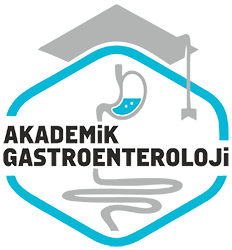Nisan 2008
Yillara göre duodenum ve mide ülserli olgularin ve bu olgulardaki Helikobakter pilori sıklığınin irdelenmesi: Retrospektif 10 yillik irdeleme
Analysis of frequency of duodenal and gastric ulcer patients and frequency of Helicobacter pylori in these cases according to each year: A 10-year retrospective analysis
- Ana Sayfa
- Sayılar
- Nisan 2008
- Yillara göre duodenum ve mide ülserli olgularin ve bu olgulardaki Helikobakter pilori sıklığınin irdelenmesi: Retrospektif 10 yillik irdeleme...
Özet
Giriş ve Amaç: Bu çalışmanın amacı, üst gastrointestinal sistem endoskopisi yapılan olgular içinde duodenum ve mide ülseri ve bu olgulardaki Helikobakter pilori sikligini yıllara göre irdelemektir. Gereç ve Yöntem: Temmuz 1996-Haziran 2005 tarihleri arasında Ege Üniversitesi Tıp Fakültesi Gastroenteroloji Klinik arsivine ait tüm üst gastrointestinal endoskopi kayitlari incelenmıştır. Duodenum ve mide ülserli olgularin sikligi beser yıllik dönemler ve yıllara göre ayri ayri değerlendirilmıştır. Helikobakter pilori varligi hizli üreaz testi ile değerlendirilmıştır. Duodenum ve mide ülseri sikligini saptamak için tüm ülserli olgular değerlendirmeye alinirken, Helikobakter pilori pozitifliği sikligini saptamak için, kayitlarda üreaz testi sonucu bulunan olgular değerlendirilmıştır. Bulgular: 1996-2005 yıllari arasında toplam 35957 endoskopi yapilmıştır. Olgularin 1677 (%4.6)’sinde mide ülseri, 4281 (%11.9)’sinde de duodenum ülseri saptanmıştır. Beser yıllik dönemler ve yıllara göre ayri ayri değerlendirildiginde, mide ülseri sikliginda anlamli bir degisıklık olmadi- gi saptanmis, ancak duodenum ülseri sikliginda azalma olduğu dikkati çekmıştır. Hem beser yıllik dönemler hem de yıllara göre ayri ayri değerlendirildiginde, duodenum ülserli olgulardaki Helikobakter pilori sikliginda azalma olduğu saptanmıştır. Mide ülserli olgulardaki Helikobakter pilori sikliginda yıllara göre değerlendirildiginde fark saptanmamis, ancak bu olgularda ikinci 5 yıllik perioddaki Helikobakter pilori sikliginda azalma olduğu dikkati çekmıştır. Sonuç: Ikinci bes yıllik periodda mide ülserli olgularda Helikobakter pilori pozitifliği yönünden anlamli bir azalma olmasina karsin, mide ülseri görülme sikliginda belirgin bir azalma saptanmamıştır. Bu durumun, mide ülseri etyopatogenezinde önemli bir rolü olan nonsteroidal anti-inflamatuvar ilaçlarin kullanımının artisi ile ilişkili olabilecegi düşünülmüştür. diğer taraftan duodenum ülseri sikligi ve bu olgulardaki Helikobakter pilori sikligi belirgin olarak azalmaktadi r. Duodenum ülseri sikliginin yıllara göre giderek azaliyor olmasi, Helikobakter pilorinin eradikasyonu ile ilişkili olabilir.
Abstract
Background and aims: The aim of this study was to evaluate the frequency of the duodenal and gastric ulcer in cases underwent to upper gastrointestinal endoscopy according to each year, and to evaluate the frequency of Helicobacter pylori in these cases with ulcers. Material and Methods: All of the upper gastrointestinal endoscopy reports from archieve of Department of Gastroenterology, Ege University Medical School between July-1996 and June-2005 were searched. The frequency of the cases with duodenal and gastric ulcer were analyzed according to each year and to the 5-year periods. The presence of Helicobacter pylori was diagnosed by rapid urease test. All of the cases with duodenal and gastric ulcer were evaluated in order to detect the frequency of ulcer, and only cases with urease test result were included into the assessment in order to detect the frequency of Helicobacter pylori. Results: Overall, 35957 endoscopies were performed betweeen 1996 and 2005. Of these, duodenal ulcer was found in 4281 (11.9%), and gastric ulcer in 1677 (4.6%) cases. There was no difference in gastric ulcer frequencies according to each year and to the 5-year periods, however, a decrease was observed in frequency of duodenal ulcer. Helicobacter pylori frequency in duodenal ulcer cases decreased according to each year and to the 5-year periods. In gastric ulcer cases, although there was no difference in Helicobacter pylori frequency according to each year, Helicobacter pylori frequency was found to be lower in the latter 5-year period. Conclusions: Although there was no difference in frequency of gastric ulcer in the latter 5-year period, a decrease was observed in frequency of Helicobacter pylori in these cases. This may be explained by an increase in the use of non steroidal anti inflammatory drugs which play an important role in gastric ulcer etiopathogenesis. On the other hand, there was a decrease in frequency of duodenal ulcer and also frequency of Helicobacter pylori in these cases. This may be explained by the eradication of Helicobacter pylori.



